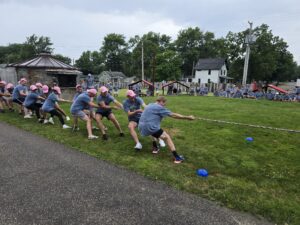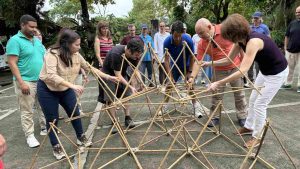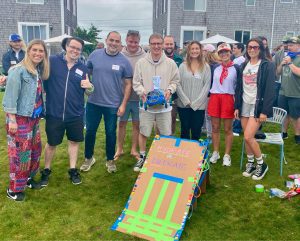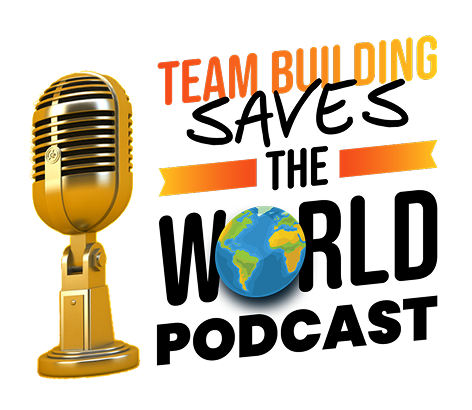Why Team Play Builds Stronger, Smarter Teams
The power of play at work is the best way to get your team truly collaborating today. If you’re here, it likely means you’re exploring fresh ways to help your employees bond through shared experiences so they can become a more cohesive, collaborative, and high-performing unit, right?
The answer lies in teamwork play. Even though it may sound like “just having fun,” there’s far more behind team play than most people realize.
Getting your people working as a team is critical to the long-term success of your business and I believe that using play is the key to making this happen. But I’m not just saying this because I happen to enjoy a good game!
The Evidence Behind the Power of Play
The method behind our approach is backed by a growing body of research showing that employees who engage in play together are:
- More productive
- More creative
- More healthy
- More motivated
- More flexible and resilient
- Better able to meet job demands
One of the greatest benefits of play is its ability to tap into your brain’s right hemisphere, which is often overlooked in the workplace. Your right brain is where imagination, creativity, and intuition live.
For years, people assumed the right brain was useful only to artists, writers, and musicians. Today we know it also plays a vital role in business success.
So let me ask you: do you want your team to brainstorm better solutions, discover innovative ways to solve problems, or spark ideas that move your company forward? The key is getting them to engage the right side of their brain… through play.
The Proof Behind the Power of Play
The benefits of play at work aren’t just theory. The results are clear. Lund University found that playful cues and improv workshops boosted creativity without slowing productivity. The Strong Museum of Play saw the same effect when simple prompts like props or candy improved meeting dynamics.
Research on playful work design shows that adding fun to the day lifts motivation, engagement, and overall performance. A 2023 Frontiers study found that teams focused on learning and cooperation became more creative, while MDPI linked positive climate and emotional intelligence with stronger results.
So why does play work so well? It taps into the right brain, the home of imagination and intuition, and it builds psychological safety. When people feel safe to experiment, fail, and share raw ideas, that’s when real innovation takes hold.
And that’s the answer to the question so many leaders ask: what is play in a workplace context? It’s not about being childish. It’s about giving adults a chance to use play as a serious tool for growth.
Why the Power of Play Matters at Work
The research is convincing, but what really excites me is how these benefits show up in action. When teams engage in adult play through well-designed activities, the lessons don’t just stay in the game. They spill over into meetings, projects, and long-term collaboration. Here’s how I see it work every day.
Team Play is Involving
The best way to learn new skills is by doing, not just by listening. Sitting through a lecture might give you information, but it rarely changes behavior. Put people into an activity (whether it’s solving a puzzle, role-playing a scenario, or diving into a hands-on challenge) and they walk away with lessons they can actually use.
I’ve seen this firsthand at events. Give a team a puzzle to solve or a cooking challenge to complete, and you’ll watch the lessons stick. Someone might discover new communication skills while plating pasta, or realize the importance of delegation while racing against the clock in a scavenger hunt. These lessons don’t just fade when the activity ends. They show up again in meetings, projects, and everyday collaboration.
Team Play is Low Risk
Failure is part of life and part of business. The trick is creating space where it’s safe to stumble. Play provides that environment. When teams experiment in a playful setting, they’re more likely to take risks, toss out bold ideas, and test solutions they wouldn’t normally consider.
Think about it: Thomas Edison famously discovered over 1,800 ways not to build a light bulb. In our world, those “not quite right” moments during a team challenge often spark surprising breakthroughs. A group might fumble through the first round of a game show, then completely crush it once they’ve learned from their mistakes. In play, failure becomes fuel.
Team Play Explores Team Dynamics
Every team has its own personality and play is one of the fastest ways to see it in action. Who naturally takes the lead? Who listens quietly but notices the small details? Who jumps in with energy and ideas? These roles often become clear when people are in motion and engaged.
As a leader, observing your team in play gives you insight you just can’t get around the conference table. You see how decisions are made, how conflict is handled, and how people adapt to change. Those lessons help you support your team better back in the workplace.
Team Play Promotes Self-Awareness
Play also gives individuals a chance to surprise themselves. I’ve lost count of how many times I’ve heard, “I had no idea Sarah was such a natural strategist,” or “Who knew James had such a quick sense of humor?” These moments shift the way team members see each other and themselves.
When people recognize their own strengths and those of their teammates, they bring more confidence and empathy to the table. That’s a big part of building a stronger, more effective team.
Playing as a Team Builds Trust
Trust doesn’t happen automatically. It builds over time, through shared experiences. Play accelerates that process by lowering barriers. When people laugh together, solve challenges side by side, or even lose a game with good humor, they grow closer.
I’ve watched groups walk into an event as colleagues and walk out with a sense of connection that feels more like friendship. That trust carries into the workplace, making collaboration smoother and conflicts easier to resolve.
Team Play Shows the Value of the Team
Not everyone is a natural believer in teamwork. Some are fiercely independent, while others may simply have little experience working in a group. Play offers the perfect way to show skeptics what collaboration can accomplish.
During a well-designed team activity, people see for themselves how sharing information and responsibilities produces better results. They also discover the value of diverse perspectives: how someone else’s idea, skill, or approach can make the whole team stronger.
Team Play Promotes Pleasure
Here’s something we forget too often: pleasure matters. Studies consistently show a link between enjoyment and productivity. When people have fun while learning, they’re more engaged and more likely to remember what they’ve learned.
I like to think of pleasure as the secret ingredient that makes team building stick. The smiles, the laughter, the sense of accomplishment — all of that helps recharge morale and rekindle excitement about work.
Team Play Provides Goal-Oriented Lessons
Every TeamBonding event is built with intention. Whether your team needs to sharpen problem-solving, strengthen communication, or simply reconnect after a stressful season, there’s a program designed to meet that goal.
Some teams love the energy of a citywide scavenger hunt. Others prefer a culinary challenge, a charitable bike build, or a hands-on creative project. The activity itself is flexible, but the outcome is always the same: your team walks away with lessons they can apply directly at work. And because those lessons are learned through play, they stick.
The Lasting Benefits of Play at Work
When I think about the teams I’ve worked with over the years, the most memorable breakthroughs rarely happened in a boardroom. They happened in moments of play: when people were laughing, experimenting, and discovering new sides of themselves and each other.
That’s the real power of play. It makes learning enjoyable, it builds trust, and it strengthens the connections that carry over into the workplace.
If you want your team to be more creative, resilient, and engaged, don’t underestimate what play can do. Whether it’s a scavenger hunt through your city, a cooking challenge in the office, or a charitable project that gives back to the community, play gives people the chance to grow together.
At TeamBonding, we’ve seen again and again how the right experience can transform a group into a stronger, more connected team. If you’re ready to see the benefits of play in action, explore our programs and find the experience that fits your goals.
Get more insights in our newsletter:
* every subscription supports charity!
Plays well with these activities.


 Unlock exclusive resources for better teams. Every subscription supports charity!
Unlock exclusive resources for better teams. Every subscription supports charity!
Create Your Free Account
Get exclusive access to new programs from the TeamBonding Lab, save your favorite ideas, and track your upcoming events.
Already have an account? Login










